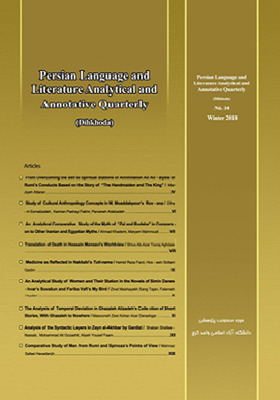-
-
List of Articles
-
Open Access Article
1 - From Overcoming the Self to Spiritual Stations of Annihilation An Analysis of Rumi’s Conducts Based on the Story of “The Handmaiden and The King”
Marziyeh Attaran -
Open Access Article
2 - Study of Cultural Anthropology Concepts in M. Moaddabpour’s Roxana
Elham Esmailzadeh kamran pashaie fakhry parvaneh adelzadeh -
Open Access Article
3 - An Analytical Comparative Study of the Myth of “Zal and Rudaba” in Comparison to Other Iranian and Egyptian Myths
maryam mahmoodi ahmad khademi -
Open Access Article
4 - Translation of Death in Hossein Monzavi’s Worldview
Shiva Abazar Tooraj Aghdaie -
Open Access Article
5 - Medicine as Reflected in Naghšabi’s tuti-nāma
hamidreza farzi Hosein Soltani Ghadim -
Open Access Article
6 - An Analytical Study of Women and Their Station in the Novels of Simin Daneshvar’s Suvašun and Fariba Vafi’s My Bird
Zinat Mashayekh Sang-Tajan Fatemeh Heydari -
Open Access Article
7 - The Analysis of Temporal Deviation in Ghazaleh Alizadeh’s Collection of Short Stories, With Ghazaleh to Nowhere
Masoumeh Zare Kohan Azar Daneshgar -
Open Access Article
8 - Analysis of the Syntactic Layers in Zayn al-Akhbar by Gardizi
Shaban ShafieNassab mohammadali gozashti alieh yoseffam -
Open Access Article
9 - Comparative Study of Man from Rumi and Spinoza’s Points of View
Mahnaz Safaei Havadaraqh
-
The rights to this website are owned by the Raimag Press Management System.
Copyright © 2021-2025







